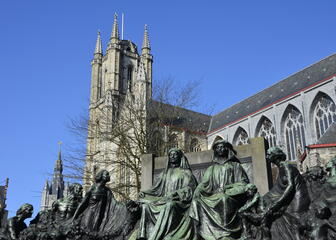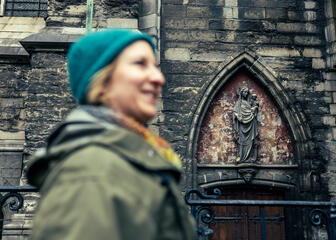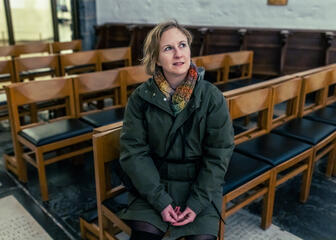

Behold the Lamb of God who takes away the sins of the world...
Shall I begin with a confession? The first time I saw the Ghent Altarpiece in real life was in 2017, when I stepped into the renovation and restoration project. I’m not particularly proud of having to admit it, since I was born and bred in Ghent, I studied art history and, of course, I had read a great deal about the Ghent Altarpiece. But I had never actually seen it.

So the first time was in the restoration studio. There I was, seeing the panels with my own eyes, without any barrier between me and the painting. “Come a little closer,” the restorers told me. But I was afraid to come too close. At such a moment, you immediately feel your nose itching and think: don’t sneeze, don’t sneeze ...
Flemish masterpiece in the bunker
In my defence: the Ghent Altarpiece used to be displayed in a space that was not very welcoming. Since 1986, it had been kept in the Villa chapel, on your left side when entering the cathedral. In the 1980s, Belgium was terrorised by the Brabant killers and the Communist Combatant Cells; everyone was afraid of bombings. That’s why they built a kind of bunker inside the chapel. But the space was much too small for all those visitors. You could hardly see the rear panels, and not at all if you were in a wheelchair.

In fact, Jan Van Eyck had originally painted the altarpiece for the Vijd chapel, at the front right of the cathedral, the private chapel of Joos Vijd and Elisabeth Borluut. Just take a look at the large figures on the rear panels: light falls on them from the right-hand top corner. This perfectly matches the space as it was back then. In the 15th century, the altarpiece was closed for most of the time. So people usually only saw the subdued colours of the outer panels. The altarpiece was only opened on feast days. Imagine the impact of all those colours, back in the day …
Is the Ghent Altarpiece now displayed in the best possible conditions? Take a look for yourself, and take your time. I have certainly more than made up for the lost time.
In the garden or underground?
So the question arose: where should to the painting be displayed? Moving it back to the Vijd chapel was not an option, as this space is too small. And it was impossible to place a glass case in the chapel to control the temperature and humidity, a necessity for the conservation of an artwork of nearly 600 years old.

Moving the work to a museum would have been the easiest option, but we did not want to take it out of context. It belongs in the cathedral. In other places, masterpieces have been removed from the site for which they were intended, and we really wanted to avoid that in Ghent. It’s the only option that has never been considered by us. Should the new structure be built in the garden of the episcopal palace? Or underground? We came up with all sorts of wild ideas.
The new exhibition space
Eventually, we chose the Sacrament chapel, at the back of the cathedral in the chancel. It is the largest of all side chapels and the sunlight entering from the south is comparable to that in the Vijd chapel. Actually, it is mainly about the idea, because the painting may no longer be exposed to direct sunlight. To limit the number of ‘sunlight hours’, we even installed a light-blocking curtain around the glass case.

In any case, the location and context just felt right. The Flemish masterpieces council, the fire brigade, the Flanders Tourism agency, accessibility firm Inter: they all had their opinion. But in the end, it was up to the parochial church council to make the decision: the building’s religious function may not be forgotten. And putting it all the way at the front of the cathedral felt right.
Safe and sound
The glass of the display case is state-of-the-art. It is heated to avoid even the slightest temperature fluctuation and, of course, it is extremely strong. As far as we’re concerned, one stolen panel is quite enough. Now that I’ve touched upon the ‘Just Judges’ panel: you can really see the effect of the restoration on the painting.

When Jef Van der Veken painted a copy to replace the stolen panel in 1939, his use of colours was influenced by the condition the painting was in at the time. Nowadays, the yellowed varnish has been removed from the other panels, so that the sky is once again bright blue. As a result, the colours no longer match. That’s why we have shone a blue spotlight on the ‘Just Judges’ panel, so it matches the rest of the painting better.
Is the Ghent Altarpiece now displayed in the best possible conditions? Take a look for yourself, and take your time. I have certainly more than made up for the lost time.
Maaike Blancke
Maaike Blancke (Bressers Architecten) from Ghent is an art historian, interior architect and restoration expert. She worked on several Ghent landmarks, including the kiosk in Citadelpark and the Town Hall, but her biggest feat so far is the new visitor centre in St Bavo's Cathedral which houses the restored Ghent Altarpiece.























